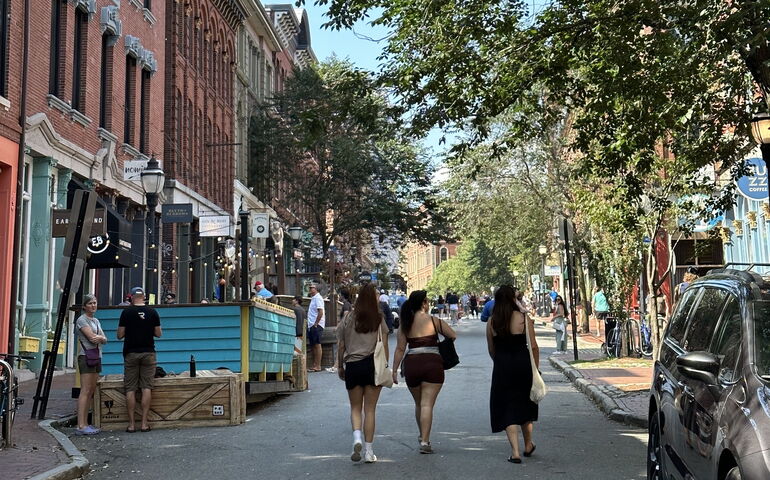
Portland’s post-pandemic recovery has been uneven, MIT study says
 Photo / Courtesy, Jeff Levine
Downtown Portland’s recovery from the pandemic has been uneven, according to a new study.
Photo / Courtesy, Jeff Levine
Downtown Portland’s recovery from the pandemic has been uneven, according to a new study.
Downtown Portland’s recovery from the pandemic has been uneven, with the Old Port back to its bustling ways but the Arts District and blocks around Congress Street not faring as well.
A new study out of the Massachusetts Institute of Technology identifies the usual suspects as some reasons for the challenge: workforce shortages and the lack of affordable real estate.
But the top concern? Businesses want the city to build more public restrooms.
Continued loss of revenue

In October 2020, former MIT student Emma Gonzalez Roberts and faculty member Jeff Levine conducted a study called “Rebuilding Main Street After COVID-19,” which looked at the pandemic’s impact on six cities in New England and the Upper Midwest. Portland was among the six — and familiar territory for Levine, who served as the city's director of planning and urban development from 2012-19.
The goal of the original research was to understand potential long-term changes to downtown commerce and the role of public policy and planning in supporting changes.
Four years later, the researchers returned to Portland for a focused follow-up that included interviews with Cary Tyson, executive director of Portland Downtown, and Eamonn Dundon, director of advocacy at the Portland Regional Chamber of Commerce. There was also a survey of downtown small business owners, which received 24 responses.
In the 2020 project's survey, respondents shared Information about their immediate needs to stay in business, along with anticipated long-term challenges and regulatory changes that might be needed.
The 2024 survey reframed the questions to understand whether and how the challenges played out as expected.
Challenges that persisted included:
- Rising costs of goods, licensing, rent and labor
- Hiring and labor shortages
- Continued loss in revenue compared to pre-COVID.
More public restrooms
Asked what regulatory changes would be most helpful for their businesses, respondents’ top response was the addition of public restrooms in the downtown area.
That was followed by financial incentives, such as additional funding for making physical changes to a business space, and land use and zoning changes that would encourage more people to work and live downtown.
Respondents also commented on the need for more affordable housing downtown.
“Portland need affordable housing downtown so young employees can live and work in the Old Port,” said one respondent. “Catering to the rich and out-of-staters will be the downfall of Portland’s vibrant food and drink scene.”
Nearly 70% of respondents said they’ve noticed a drop in foot traffic and said they believe that has negatively affected their business
Location matters
Location matters, the study says. Small business activity in the Old Port has largely bounced back. But other areas such as the businesses along Congress Street have continued to struggle.
Long-term effects of the pandemic are felt most in debt, labor to maintain and update business’s online presence and inventory, and maintaining health protocols.
The study identifies a concern that the rising cost of commercial and residential rents downtown will push out small businesses, and adds to the challenges of hiring and keeping a customer base. Restaurants continue to struggle to find sufficient staff, which hinders their capacity to grow. The municipal government struggles to fill vacancies, which makes it difficult to maintain the downtown environment.
Small businesses consistently spoke to the need to build more housing downtown, and at rates accessible to locals. Construction of housing and extended stay hotels has begun to occur, including new buildings and conversion of office space to apartments and condos. But buildings that have recently opened tend to be marketed for higher-end living.
The Old Port has long been the center of Portland’s tourist economy and considered prime retail spaces for restaurants and small businesses. This reliable source of activity has bolstered its recovery, the study says.
But along Congress Street and areas nearby, large infrastructure projects such as the redesign of Congress Square have been a challenge for small businesses. The closure of some key businesses early in the pandemic has brought persistent vacant storefronts.
Conclusions
The study identifies some paths forward, including:
- The addition of public restrooms in the downtown area
- Financial incentives such as additional funding for making physical changes to business space, such as expansions
- Land use and zoning changes that would encourage more people to work and live downtown.
The report's authors say its goal was to serve as a conversation starter for planning and policy, to support small businesses that are now in a new and distinct phase of pandemic recovery.
To view the full report, click here.









0 Comments